 Artist: Saunders Hildreth
Artist: Saunders Hildreth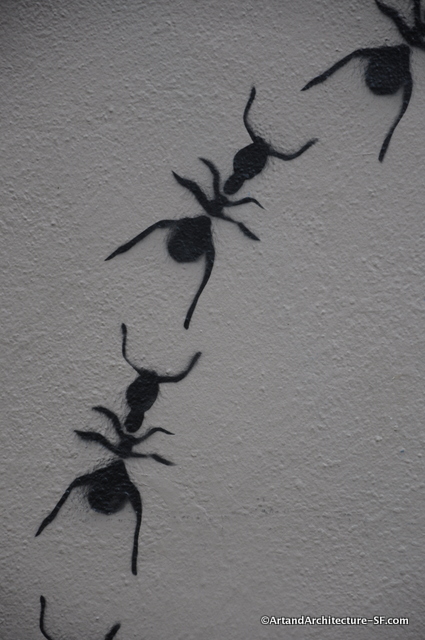 Jeremy Nova – Great Spirits Have Always Encountered Violent Opposition From Mediocre Minds – Einstein
Jeremy Nova – Great Spirits Have Always Encountered Violent Opposition From Mediocre Minds – Einstein
 Artist: Saunders Hildreth
Artist: Saunders Hildreth Jeremy Nova – Great Spirits Have Always Encountered Violent Opposition From Mediocre Minds – Einstein
Jeremy Nova – Great Spirits Have Always Encountered Violent Opposition From Mediocre Minds – Einstein
Born, Beniamino Bufano, in San Fele, Italy, in 1886, he was one of sixteen children. His family immigrated to New York when he was three, and at six he began contributing to the family income by shining shoes and peddling newspapers. He dropped out of school after the third grade, but entered art school as a teenager, working there as a janitor in lieu of tuition. Later he became apprenticed with the sculptor James Frasier, while he continued to work as a janitor.
In 1915, a fellow sculptor, who’d been selected to create works for the Panama Pacific International Exposition, offered Benny a job as his assistant. Once in San Francisco, Benny’s talents were recognized, and he began receiving regular and lucrative commissions. Saint Francis is the patron saint of San Francisco. Born Giovanni Francesco di Bernardone; 1181/1182 – October 3, 1226, Saint Francis was an Italian Catholic friar and preacher. He founded the men’s Franciscan Order, the women’s Order of St. Clare, and the lay Third Order of Saint Francis. St. Francis is one of the most venerated religious figures in history. The statue was brought to Fisherman’s wharf to stand a few yards from the Longshoremen’s Memorial Building honoring famed unionist Harry Bridges.
The statue stands 18 feet tall and weights 12.5 tons. In 1928, while the statue was being exhibited in Paris, where Bufano sculpted it, the late English art Critic Roger Fry wrote that is was “the most significant piece of sculpture done within 500 years.” The statue was brought to San Francisco in 1955 through the efforts of Bufano’s close friend Paul Verdier, owner of the City of Paris department store, mayor Elmer Robinson and the French government. San Francisco is lucky to have many of Bufano’s pieces scattered throughout the city, here are a few others.
Three firemen grouped on a circular base, are standing, dressed in uniform. Two have hats on. One firefighter carries a woman in his arms; another holds what appears to be a bullhorn, and the third (behind the other two) holds a firehouse.
This statue was paid for by a portion of the monies left behind by Lillie Hitchcock Coit.
“Maru” means “circle,” the word is frequently added to names of Japanese ships “as a way of blessing the vessel, wishing it safe travels and a safe return to port, thus closing the circle.
There are two sculptors listed for this monument. Mitsui Nakai and Ishi Katsu.
I am sharing with Sundays in My City
The stone reads: We are grateful, as we stand facing this monument, for the infinite gifts of heaven and earth. We recognize once again the true fundamental of the human should that pursues the truth, implements the good, creates beauty, and renews his will to step forward. This way brings about peace in mind and on earth by mutual understanding, encouragement and help. It was in this spirit that this monument was built.
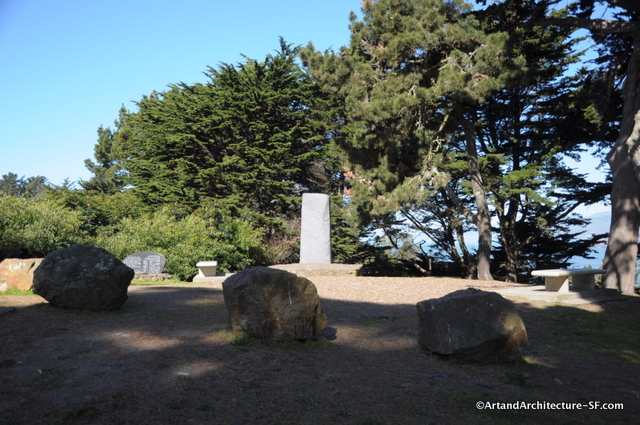 This piece is owned by the San Francisco Parks and Recreation Department. According to a Japanese Encyclopedia, Bundo Shunkai (1878-1970) was a Calligrapher and Buddhist monk, Sojo (bishop) of the Tendai sect. He was a student of Nishikawa Shundo. His style was flexible yet firm.
This piece is owned by the San Francisco Parks and Recreation Department. According to a Japanese Encyclopedia, Bundo Shunkai (1878-1970) was a Calligrapher and Buddhist monk, Sojo (bishop) of the Tendai sect. He was a student of Nishikawa Shundo. His style was flexible yet firm.
Henri Marie-Rose (1922-2010) born in François, Martinique, the son of Appien Constance Raymonde and Quentin Joseph Marie-Rose Dite Cétoute, Henri Marie-Rose Dite Cétoute, who later simply went by Henri Marie-Rose, was a San Francisco resident for 58 years, living initially in North Beach before settling on Potrero Hill.
He attended the École des Arts et Métiers and the École des Arts Appliqués in Martinique. He had three one man shows in 1940, 1942 and 1943 and was appointed Attaché Culturel au Projet d’Urbanisme,
Shortly thereafter, he was awarded a scholarship by the French Government to study at the École National Supérieure des Beaux Arts in Paris, but got only as far as North Africa when the Second World War broke out.
Eventually Henri studied at “Beaux Arts” for over eight years. During this period, he met an art student, Marjorie Raitt, who was attending the Sorbonne and the Académie Julian, having recently graduated from Stanford. The couple married in 1952 and traveled by freighter to San Francisco the following year. Within weeks of his arrival, he won the Emanuel Walter Purchase Prize, & later hosted an 18 week series on KQED entitled “Techniques in Sculpture”. In 1960, his work was exhibited in a one man show at the De Young Museum. He went on to exhibit across the country & in Brazil. He spent his final 12 years as a teacher & mentor for Recology’s Artists in Residence Program.
This piece is copper and is part of the San Francisco Civic Art Collection.
*
This cast concrete panel by Horace Washington depicts the cultural diversity of the Western Addition and its architectural history. The panel also features the likeness of police officers of the past. The piece is part of the San Francisco Arts Commission collection and was produced in 1987. It is 3 feet high by 8 feet long.
Horace Washington (who has work on the 3rd Street Light Rail project) studied at Columbus College of Art and Design in Ohio before moving to California to study sculpture at the San Francisco Art Institute and then completed his graduate studies at Cal State University, Sacramento. He is a San Francisco sculptor and muralist whose works include numerous projects in a variety of materials for public facilities in northern California including the International Longshoremen’s & Warehousmen’s Union mural/ scultpure, the Northern Police Station sculpture, the Martin Luther King Swimming Pool Tile Murals, and the Plaza East ceramic tile and painted mural. He exhibits his work in San Francisco and has been a guest lecturer at UC Berkeley, Cal State Sacramento, and for the San Francisco Unified School District. He has also taught developmentally disabled adults at the Creativity Explored Art Center. He lives and works in San Francisco.
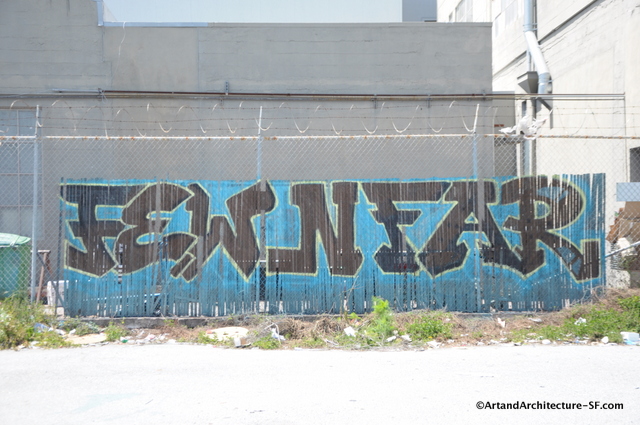 Continuing with the Few N Far Crews work at 69 Duboce.
Continuing with the Few N Far Crews work at 69 Duboce.
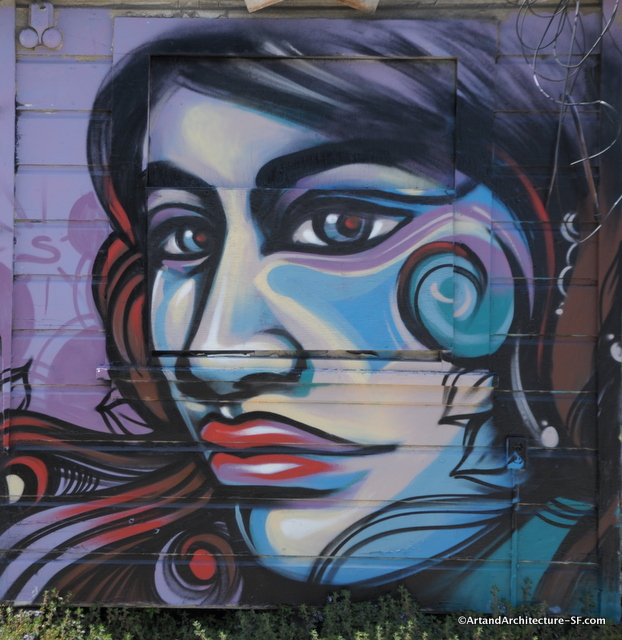 Meagan Spendlove – Meagan has murals all over town.
Meagan Spendlove – Meagan has murals all over town.
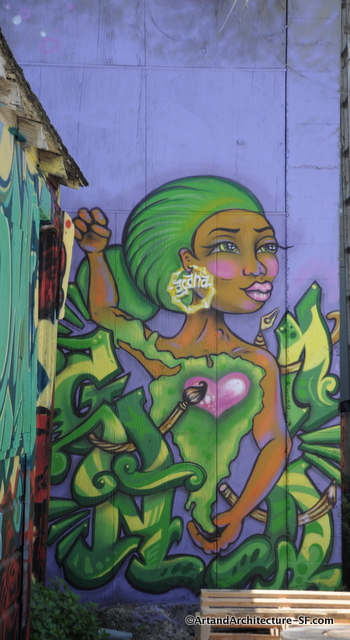 Agana is from Oakland. From Few and Far’s Website: Agana is not only a bad ass DJ but she is an art teacher, muralist, jewelry maker, loving/giving friend, always down to paint no matter what!! Agana also films and edits her own videos.. Oooh yes, don’t let me forget to mention… she always has her nails on point every time!
Agana is from Oakland. From Few and Far’s Website: Agana is not only a bad ass DJ but she is an art teacher, muralist, jewelry maker, loving/giving friend, always down to paint no matter what!! Agana also films and edits her own videos.. Oooh yes, don’t let me forget to mention… she always has her nails on point every time!
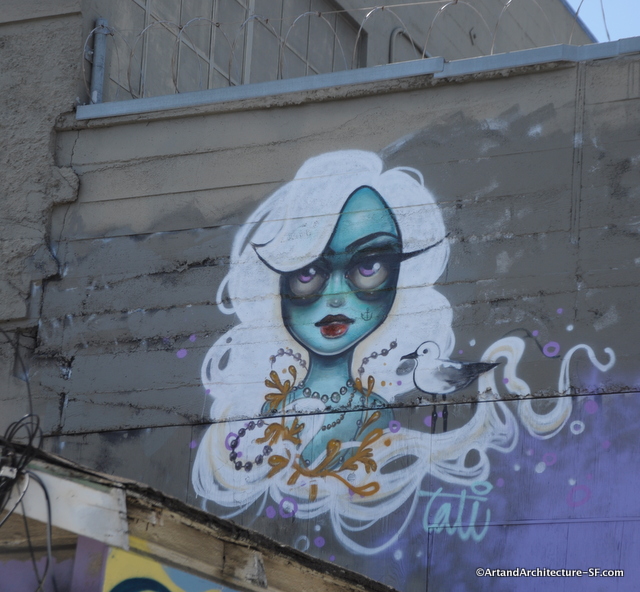 Tatiana Suarez is from Miami and New York. According to Tati’s website: Tatiana Suarez (b. 1983) is a Brooklyn-based Miami native. Her charming style is distinctive — first, the trademark eyes that draw the viewer into a beautiful and surreal world. Suarez takes full advantage of the oil paint’s ability to create creamy, soft images on canvas. Rich with symbols that stem from her Brazilian and El Salvadorian heritage, subjects appear as if they are under water, frozen in lovely stillness. The doe-eyed figures look childlike, but also exude sexual overtones, ornamented with plants, insects and other unsettling accompaniments. Beauty is presented concurrently with exotic — even creepy — creatures to create enchanted narratives.
Tatiana Suarez is from Miami and New York. According to Tati’s website: Tatiana Suarez (b. 1983) is a Brooklyn-based Miami native. Her charming style is distinctive — first, the trademark eyes that draw the viewer into a beautiful and surreal world. Suarez takes full advantage of the oil paint’s ability to create creamy, soft images on canvas. Rich with symbols that stem from her Brazilian and El Salvadorian heritage, subjects appear as if they are under water, frozen in lovely stillness. The doe-eyed figures look childlike, but also exude sexual overtones, ornamented with plants, insects and other unsettling accompaniments. Beauty is presented concurrently with exotic — even creepy — creatures to create enchanted narratives.
This is an empty lot that was taken over (with permission) by Few and Far. Few and Far is a woman’s street art group and this is what they say about themselves on their blog:
Few and Far is a movement that brings together talented women who are involved in graffiti, Skateboarding and street art from all over the world. Few and Far connects women by creating social and artistic exchange, by showcasing art on the streets, on walls and in other high profile venues. Few and Far fosters and celebrates the power and expression of female street artists. Importantly, Few and Far consists of a team of open minded, highly creative, cutting edge and dedicated every day females. We seek to expand this movement with the involvement more around the globe, and hope to highlight their commitment to their craft. Also Building life long friendships.
The group is made up of a quite a number of women.
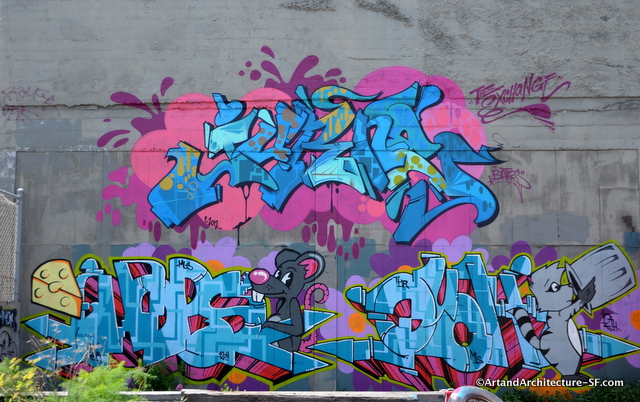 Hops is from Seattle. (From Few and Far’s Blog) Few & Far’s Hops is such a dope person on many levels. She is very motived, fast and clean painting, often finished before any of us have our final outlines up. She paints anything she gets her hands on!
Hops is from Seattle. (From Few and Far’s Blog) Few & Far’s Hops is such a dope person on many levels. She is very motived, fast and clean painting, often finished before any of us have our final outlines up. She paints anything she gets her hands on!
Joshua, a Minnesota resident, is a truly prolific muralist. Joshua Sarantitis has been creating monumental professional work in public spaces for over 20 years. His 40 commissioned works include glass installations and mosaic murals located regionally and abroad including San Francisco, Chicago, Philadelphia, Cleveland, Los Angeles, Minneapolis, Phoenix and Tucson. His ability to collaborate successfully with design professionals, arts administrators and community is rooted in a desire to find common language between our everyday lives and the arts. Joshua embraces using technology as a tool to aid in mastering media including slumped and fused glass, mosaic, plasma-cut steel, concrete, glass frit, ceramic toner on glass, ceramic tile and paint and fiber. He combines the desire for learning with the skilled execution of an accomplished technician.
This was one of Joshua’s first murals. It was done in conjunction with Precita Eyes. It was funded by P.G.&E., The Neighborhood Beautification Fund, and the Graffiti Clean Up Fund.
The San Francisco Mission District has been hosting a Carnaval Festival since 1978. There is a very elaborate parade, afterwards streets are blocked off and food and entertainment can be enjoyed to ones hearts’ content.
This statue to Ralston was commissioned and paid for by Edward Bowes(14 June 1874, San Francisco – 13 June 1946, Rumson, New Jersey) Bowes made his fortune in real estate in San Francisco. The 1906 earthquake made him reevaluate his life, he moved to New York and became involved in the entertainment industry. Major ( a rank he obtained in WWI, and insisted on being addressed this way for the rest of his life) Bowes’ Amateur Hour was the best-known amateur talent show in radio during its eighteen-year run (1934-1952) on NBC Radio and CBS Radio.
This is the last in a series of the murals of Coit Tower. There are more, unfortunately, they are not available to the public. If you are interested in seeing pictures of them, and learning more about Coit Tower and all of the murals, I highly suggest you search out Masha Zakheim’s Book Coit Tower.
This is the second of the murals in the elevator alcove, It is titled San Francisco Bay, North and is by Jose Moya Del Pino (1869-1969). The two young men represent Moya del Pino himself watching as fellow artist Otis Oldfield sketches what he sees below him. If one looks closely you can see the former prison on the island of Alcatraz. This too is oil on canvas.
Jose Moya del Pino was born in Priego, Spain. By 1907, Moya was studied at the Academy of Fine Arts in Madrid, and associated with the Post-impressionists of Spain including Juan Gris and Diego Rivera. In the 1920’s he spent four years painting forty-one reproductions of Valasquez’s paintings in the El Prado in Madrid and Valencia. King Alfonso asked him to travel with the collection as a goodwill gesture when it went to the new world. The exhibit ended in San Francisco and Moya remained. Otis Oldfield was responsible for Moya being hired for the Coit Tower project. Later projects for Moya included a post office in Stockton as well as public art projects in Redwood City and San Rafael, California.
In the alcove, where visitors wait for the elevator are four more murals. This one is titled San Francisco Bay. This is an oil on canvas, and was painted in the artists studio. The two little girls are the artists, Otis Oldfield’s, daughters, Rhoda and Jayne. as they look down on the waterfront from their father’s Telegraph Hill studio. The larger island they are peering at is Yerba Buena Island. That is the island that the present day San Francisco Bay Bridge goes through. Treasure Island, which would have been attached on the left hand side of Yerba Buena, had not yet been built. Treasure Island was built (from fill dredged from the bay) for the Golden Gate International Exposition in 1939-1940.
Otis Oldfield was born in Sacramento in 1890. He came to San Francisco to enroll in Arthur Best’s private art school. In 1911, he went to Paris, where he stayed for sixteen years. In 1924, he began teaching at the California School of Fine Arts. He died in 1969.
The Coit Tower murals were painted during a particularly disruptive period in U.S. History. Depression related economic challenges led to much discussion about alternate forms of government. A four day general strike (Bloody Thursday) accompanied by widespread rioting in San Francisco triggered an eighty-three day 1934 West Coast Waterfront Strike.
Coit Tower muralists protested and picketed at the tower when Rivera’s mural commissioned for Rockefeller Center in New York City was destroyed after he refused to change an image of Lenin in the painting.
The opening of Coit Tower and the display of its murals was delayed several months because of the controversial content of some of the paintings. Clifford Wight’s mural, which contained a hammer and sickle as one of a series of medallions illustrating the range of political philosophies existing in America, was removed before the opening.
This particular mural depicts the anger that the artists felt at the destruction of Rivera/Rockefeller mural and the general tenet of the time.
Ralph Stockpole is reading a headline concerning the destruction of the Diego mural. Col. Harold Mack (on the Washington appointed supervisory committee for the murals) looks on while artist John Langley Howard holds a crumpled newspaper while reaching for Marx’s Das Kapital. Joseph Danysh (later federal Art Project director) holds a paper about mortgage foreclosures. Above the window are three Hebrew letters that spell out the contents of the three books lying on their sides: Torah, Prophets and Wisdom Literature.
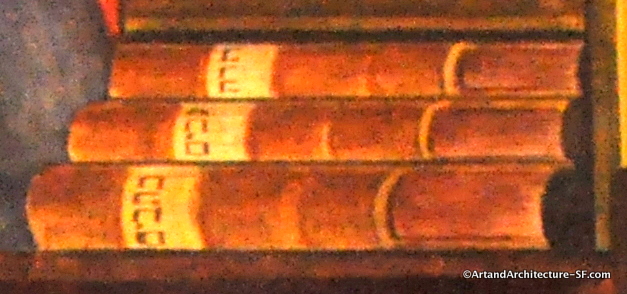 For those of you that are not familiar with the Rockefeller/Rivera controversy, here is a synopsis.
For those of you that are not familiar with the Rockefeller/Rivera controversy, here is a synopsis.
By 1930, Mexican muralist Diego Rivera has gained international favor for his lush and passionate murals. Inspired by Communist ideals and an intense devotion to his cultural heritage, Rivera creates boldly hued masterpieces of public art that adorn the municipal buildings of Mexico City. His outgoing personality puts him at the center of a circle of left-wing painters and poets, and his talent attracts wealthy patrons, including Abby Aldrich Rockefeller. In 1932, she convinces her husband, John D. Rockefeller, Jr., to commission a Rivera mural for the lobby of the soon-to-be-completed Rockefeller Center in New York City.
Flush from successes in San Francisco and Detroit, Rivera proposes a 63-foot-long portrait of workers facing symbolic crossroads of industry, science, socialism, and capitalism. The painter believes that his friendship with the Rockefeller family will allow him to insert an unapproved representation of Soviet leader Vladimir Lenin into a section portraying a May Day parade. The real decision-making power lies with the Center’s building managers, who abhor Rivera’s propagandistic approach. Horrified by newspaper articles attacking the mural’s anti-capitalist ideology, they order Rivera to remove the offending image. When Rivera refuses, offering to balance the work with a portrait of Abraham Lincoln on the opposing side, the managers pay his full fee, bar him from the site, and hide the mural behind a massive drape. Despite negotiations to transfer the work to the Museum of Modern Art and demonstrations by Rivera supporters, near midnight, on February 10th, 1934, Rockefeller Center workmen, carrying axes, demolish the mural. Later, Rivera recreates the frescoes in the Palace of Fine Arts in Mexico City, adding a portrait of John D. Rockefeller, Jr., in a nightclub. Rivera never works in the United States again, but continues to be active, both politically and artistically, until his death in 1957.
Mallete Dean was one of the more prolific painters of government sponsored murals in Northern California. Born in Washington in 1907, he studied at the California School of Fine Arts. He was a furniture designer, decorator of books and graphic artist, for many years he created labels for the California wine industry. Other works include the orchard scene in the Sebastapol, California Post Office. He died in San Francisco in 1975.
These two are Surveyor and Ironworker. There are three windows between these two figures. Over the central window Wight painted a bridge, which had the NRA Eagle in the center. Over the right hand window he stretched a segment of chain, and in the circle appeared the words In God We Trust, then over the last window he placed a section of woven cable and a circle framing a hammer and sickle, and the words United Workers of the World. This all proved to be entirely too controversial and it was removed before the tower opened in 1934.
Clifford Wight was born in England in 1900. He and Ralph Stackpole worked with Diego Rivera in the 1920’s. Wight came to San Francisco with Rivera to work as an assistant on Rivera’s murals at the San Francisco Art Institute. He also worked with Rivera on his Detroit mural. Diego Rivera painted a portrait of Wight into one of the frescos in the Secretariat of Education in Mexico City. He returned to England and died in 1966.
Fellow artist Fred Olmsted and his assistant Tom Hayes
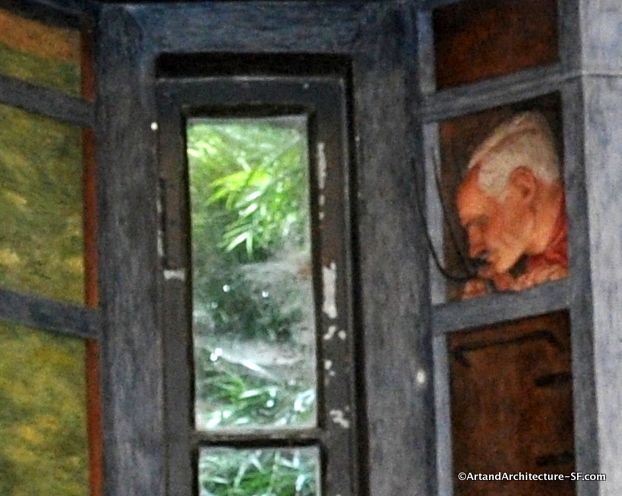 Fellow artist John Langley Howard holding a pitchfork
Fellow artist John Langley Howard holding a pitchfork
*
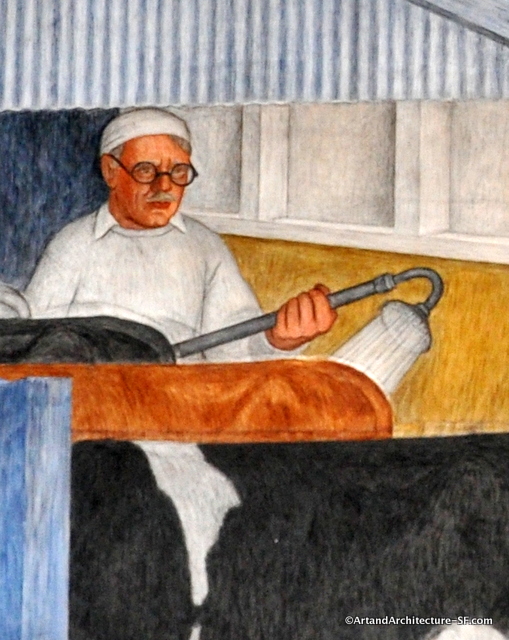 Fellow artist Lucien Labaudt showering a cow
Fellow artist Lucien Labaudt showering a cow
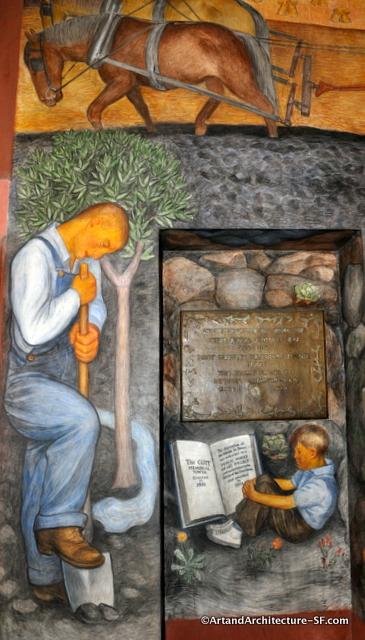 The little seated boy looks at a book whose page shows the date of Coit Tower (1933) and the date of the WPA projects at Coit Tower (1934).
The little seated boy looks at a book whose page shows the date of Coit Tower (1933) and the date of the WPA projects at Coit Tower (1934).
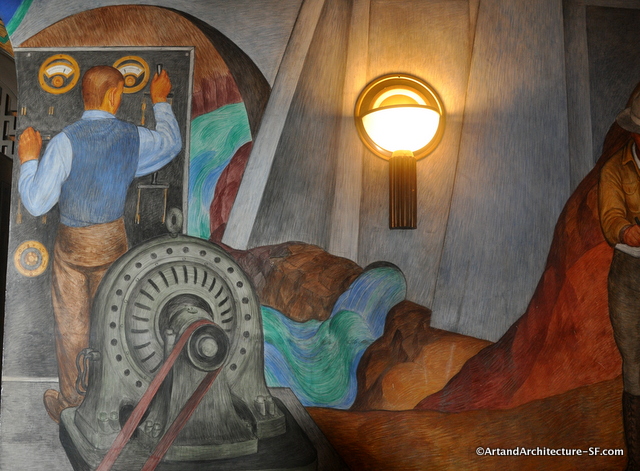 These further symbols of machine force include a man at the controls of a hydroelectric plant, a surveyor, steam shovel, and oil derricks. Notice that he had to work around not only a door, but a delightful art deco light fixture
These further symbols of machine force include a man at the controls of a hydroelectric plant, a surveyor, steam shovel, and oil derricks. Notice that he had to work around not only a door, but a delightful art deco light fixture
This law library has some interesting book titles when one looks closely. There are the usual Civil, Penal and Moral Codes, but also the Law of Fresco Painting, Counterfeiting, and Laws on Seduction. A fun one is Martial Law by Brady, he was the VFW caretaker who watched over the project and lived in the Tower’s apartment. The man on the left with the pipe is thought to be, patron of the arts, William Gerstle.
 The Stock Exchange. Notice the downward movements of the market.
The Stock Exchange. Notice the downward movements of the market.
Federal Reserve Bank. It is thought that the curly haired blond is Fred Olmsted, assistant to Coit Tower artist John Langley Howard and later an artist in the program himself.
The artist on this panel was George Albert Harris (1913-1991). Harris was one of the youngest artist to work on Coit Tower. He was a student at the California School of Fine Art and later painted a mural in San Francisco’s Chamber of Commerce building. He was a professor in the art department of Stanford University.